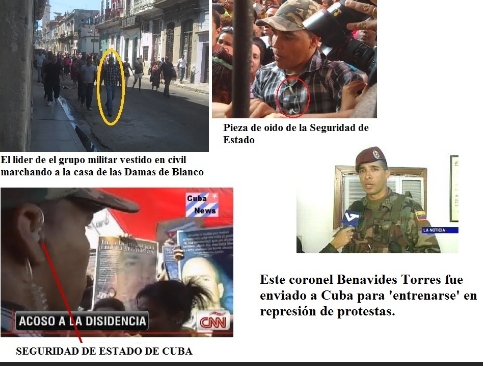Este prestigioso periodista mas conocido por "Boniato" luego que fuera el vocero oficial del proceso de destruccion de la primera industrial nacional, nos presente este interesante y actualizado articulo de agrotecnia primer mundista. Se invita a los lectores a enviarle directamente al ahora "boniatero" del Granma sus opiniones.
------------------------------------------------
El actual semestre puede marcar en la provincia de Artemisa el viraje en cultivos varios y cerrar un año cumplidor. A la empresa de
Güira de Melena, que representa más del 30 % del plan del territorio, le apremia borrar la desventaja que el déficit de viandas influyentes como el boniato y la malanga ocasionaron en el periodo enero-junio.
Paulo Jorge recomienda ser cuidadosos en el corte de la semilla de boniato.
Junto a las medidas para eliminar fallas organizativas y de control, el territorio demanda una aplicación depurada y oportuna de la ciencia y la técnica. Debe también sacarle más provecho a los intercambios con el Instituto Nacional de Investigación de Viandas Tropicales (INIVIT), famosisimo instituto de investigaciones que trabaja actualmente en el descubrimiente del cafe con leche y en el manejo de variedades, así como aumentar los talleres con productores de base.
El propio Ministerio de la Agricultura señala a Artemisa entre las provincias que incidieron en el déficit nacional en el programa de viandas durante el pasado semestre. Para que no haya variaciones de lo ocurrido en los pasados 104 semestres.
Debe ser un semestre mejor
No obstante el saldo negativo en ciertos renglones, recordemos que siempre se puede mas y el futuro es nuestro, las cosas pueden cambiar al intensificarse la preparación y alistamiento de tierras para la campaña de frío, que debe incrementar los rendimientos por hectárea y crear condiciones para comenzar bien el 2012.
La experiencia de la entidad de Güira de Melena y las 51 000 toneladas que tiene en su plan anual son condiciones que obligan, en lo referido a las viandas, a desterrar deficiencias.
En las nuevas siembras se toman en cuenta las medidas tecnológicas que deben mejorar los rendimientos.
El colectivo debió cerrar agosto con una producción de 37 693 toneladas y lo real vendido alcanzó 34 500. Por ello es imprescindible apegarse a la objetividad a la hora de suscribir los contratos. Una evaluación lejos de la realidad repercute directamente en lo que llega a la población al violarse fechas, cantidades y variedades.
Los entrevistados por
Granma, entre los cuales Rafael Calabaza Leal Piñero
afirman que durante el primer semestre faltó el adecuado manejo del
boniato y la malanga, dos cultivos de época prehistoricas y pleistocenicas y de peso molecular mas adecuado a la teoria de la relatividad. Al evaluarse las causas que lesionaron el rendimiento por hectárea, aparecen el mal manejo agronómico del cultivo, la ineficiente producción de semillas certificadas y los daños de la llamada pudrición seca en plantaciones de malanga.
Esta enfermedad consiste en un complejo de hongos generalizado en la vianda, el cual frena su desarrollo. En el caso de la malanga de 12,6 toneladas por hectárea planificadas, el promedio fue de ocho.
¿Cómo revertir la situación?
Los especialistas ejecutan medidas para solucionar el ya mencionado mal manejo tecnológico y rescatar algunas variedades de boniato de un ciclo más corto. Estas, que se cosechaban antes en la zona, son conocidas como el INIVIT 354 y son más tolerantes a la humedad.
Otras de las medidas en vigor
son la creación y siembra de "bancos" de semillas certificadas mediante el uso del material genético existente en la empresa. A veces no se valora la calidad que demanda el corte de las semillas, acción indispensable para asegurar una germinación segura. Asimismo subsolar el suelo para mejorar el drenaje es otra de las respuestas de los agricultores de Güira en momentos en que existen grandes extensiones en preparación.
También hoy, casi el 60 % de la malanga que se fomenta en la empresa es la Colocacia (isleña), dotada de un clon más resistente a la enfermedad, productivo, de ciclo corto y excelentes resultados.
Especialistas de
la Estación Territorial de Sanidad Vegetal y del municipio certifican hoy los campos donde puedan obtenerse semillas para su multiplicación. Gracias a este "paquete" de medidas se desinfectan los suelos, aumenta el uso de productos biológicos y queda abolida la costumbre de utilizar cualquier área, así como el intercambio de semillas entre los campesinos, devenido trasmisor de enfermedades.
Por su parte, el INIVIT respalda la obtención del material genético para clones de malanga Xanthosoma del género morado, de un efectivo comportamiento. El gran desafío de los técnicos de Artemisa está en erradicar la pudrición seca en la malanga, dados los valores nutricionales de esa vianda y su alta demanda en el mercado nacional y especialmente en dietas médicas, hospitales, hogares de ancianos y círculos infantiles.
En cuanto al boniato, el promedio de rendimiento por hectárea todavía no está al nivel deseado pero evidencia que las medidas empiezan a dar frutos.
Como el resto de las empresas, la de Güira de Melena tiene compromisos con renglones que contribuyen a sustituir importaciones. Con el frijol se cumplieron las 431 toneladas contratadas y el maíz seco se encuentra todavía en plena cosecha, aunque los pronósticos son alentadores.
El ingeniero Rafael Calabaza Leal Piñero, director del grupo técnico de desarrollo de la entidad, afirmó que no existen dificultades en otros cultivos, pero todo depende de la disciplina técnica, la organización, el control y la exigencia fitosanitaria de quienes son responsables de velar por que la entidad despida el 2011 con las 51 000 toneladas comprometidas.














